|
|
Someone who knows what life in a poor country and what having children means explains why Woke Culture has gone too far to young people at the Oxford Union.
The only thing Wokeness has to offer in exchange is to brainwash bright minds like you that you are victims and to complain, to protest, to throw soup on paintings.
Konstantine Kisin is a British satirist, author, and commentator who was born and raised in Moscow.
9.7 out of 10 based on 91 ratings
8.5 out of 10 based on 11 ratings
The UK set to ban sales of new petrol and diesel cars by 2030, but awkwardly, the average cost of charging an electric car has jumped by 58 per cent since last May, so sales are falling, not rising. The UK can’t afford to make them either, with BMW sending their UK electric mini factory to China. President Xi will be happy. The West thought the Glasgow commitments was a climate plan, but really it was trade deal.
h/t Notalotofpeopleknowthat
Calum Muirhead, Daily Mail
It is now expected that the UK will produce 280,000 fully electric cars and vans in 2025, down from previous estimates of 360,000.
The forecast means only a quarter of car output will be electric within the next two years, lower than prior forecasts of more than a third.
The command-economy of gas meets the command-economy of cars and pretty soon we’ll be riding horses:
In its latest report, the Advanced Propulsion Centre, which provides taxpayer funding to makers of zero-emissions vehicles, said the ‘uncertain economy’ was expected to push drivers towards cheaper car models for a longer period.
So much for that theory.
Green fantasies are a luxury item. It takes a lot of money to be this stupid. If only they had built nuclear plants or allowed cheap gas fracking…
If only they could do maths.
9.8 out of 10 based on 111 ratings
8.4 out of 10 based on 21 ratings
8.7 out of 10 based on 15 ratings
By Jo Nova
Oldbrew at Tallbloke’s Talkshop found a study showing that icebergs around Antarctica apparently haven’t changed much in the last few centuries despite an extra 2,000 Gt of CO2, and all that global warming. Remember climate change is going to hit Antarctica twice as hard as anywhere else.
As Oldbrew said: Probably not the result that was expected from this study.
Given the world warmed in the last three hundred years, it seems surprising that icebergs don’t seem to have changed. But if they had declined, this study would be a star of the news tonight. Instead I doubt many stations will report that if Captain James Cook returned today he might not see much difference.
Fascinatingly, Cook had a watch worth £450 so he could estimate longitude. To give some idea of just how fantastically valuable that watch was, ponder that the whole ship he commanded cost £1,800. The Larcum Kendall K1 watch was so prized Cook made sure “the commander, first lieutenant and astronomer were all present when it was used”.
It was modeled on the H4 clock, which only lost 5 seconds on a 81 day journey. Consider — today, we are all richer than kings.
by Todd Hollingshead, Brigham Young University
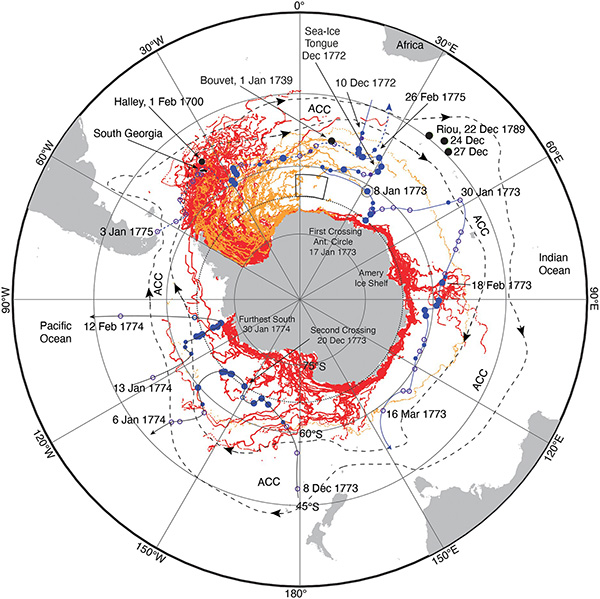 … [Phys.Org] A new study comparing observations of large Antarctic icebergs from the 1700s with modern satellite datasets shows the massive icebergs are found in the same areas where they were pinpointed three centuries ago. The study shows that despite their rudimentary tools, the old explorers truly knew their craft, and it confirms that the icebergs have behaved consistently for more than 300 years.
Using primarily the journal records of Captain James Cook’s 1772–1775 Antarctic circumnavigation on the HMS Resolution (where he noted the positions of hundreds of icebergs), a trio of researchers from Brigham Young University, NASA’s Jet Propulsion Laboratory and the University of Washington’s School of Oceanography made comparisons with the two largest modern datasets available today: the BYU/National Ice Center and Alfred Wegener Institute datasets.
They found that Cook’s description of the iceberg plume east of Antarctica’s Amery Ice Shelf, along with iceberg distributions in the Weddell, Ross and Amundsen Seas, agree with modern data. They also found additional iceberg tracking by Edmond Halley in 1700, Lozier Bouvet in 1739 and Edward Riou in 1789 are consistent with modern observations.
“Where they saw icebergs, we see icebergs now; where they didn’t seem them, we don’t see them,” said study coauthor David G. Long, BYU professor of electrical and computer engineering. “The old data from these explorers may not been very good, but it’s all that we’ve got from that time—and it’s good enough.”
Keep reading →
9.5 out of 10 based on 103 ratings
8.1 out of 10 based on 16 ratings
By Jo Nova (and UPDATED)
Across all branches of science, new ideas that reset the paradigms have quietly vanished
The spark never started in the star-ideas that should have shone, and we find ourselves suddenly under a dark sky, looking up at a galaxy of burnt gravy, thinking something is missing. As dominant paradigms became entrenched in every field of science, the great new replacement ideas starved.
Nature might as well have labeled this “A graph of Original Thought at University”
It’s like some sole giant entity infected every area of science and crushed original thinkers.
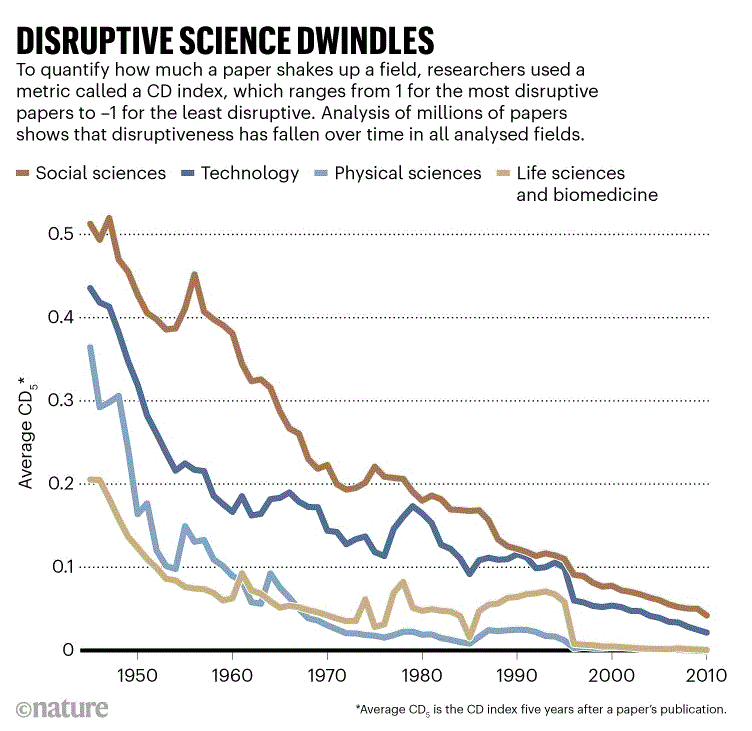 ‘Disruptive’ science has declined — and no one knows why Disruptive science sounds like something impossible to measure, but the researchers found way to test for the arrival of new papers that replace past paradigms. Genius discoveries may still have happened, but no one picked them up.
The authors reasoned that if a study was highly disruptive, subsequent research would be less likely to cite the study’s references, and instead would cite the study itself. Using the citation data from 45 million manuscripts and 3.9 million patents, the researchers calculated a measure of disruptiveness, called the CD index, in which values ranged from –1 for the least disruptive work to 1 for the most disruptive.
And it’s a wipe-out: The CD Index fell by 90% since World War II. A similar fall occurred in patents, with an 80% decline from 1980 to 2010. The language in the papers also The verbs scientists used changed too — with older papers saying they would produce or determine things, while newer papers just improve and enhance…
It’s happening in every field of science at the same time — almost like a systematic failure
Daniel Lawler and Juliette Collen explain that this is not a case of scientists discovering everything there is to know in one area:
One theory for the decline is that all the “low-hanging fruit” of science has already been plucked. If that were the case, disruptiveness in various scientific fields would have fallen at different speeds, Park said. But instead “the declines are pretty consistent in their speeds and timing across all major fields,” Park said, indicating that the low-hanging fruit theory is not likely to be the culprit.
It’s as if there is something wrong with the incentives across the board?
Looks like the rise of Government funded GroupThink?
Since World War II governments took over the role of funding science from philanthropists. Once upon a time one guy funded another one and great things happened. Now Government funded committees that are spending other people’s money, reject the risky genius and fund the middle-of-the-road instead. New ideas don’t stand a chance against monopoly science.
As Robert Zimmerman says:
…when you increasingly have big government money involved in research, following World War II, it becomes more and more difficult to buck the popular trends. Tie that to the growing blacklist culture that now destroys the career of any scientist who dares to say something even slightly different, and no one should be surprised originality is declining in scientific research. The culture will no longer tolerate it. You will tow the line, or you will be gone. Scientists are thus towing the line.
Naturally, Nature, a product made for government funded science, doesn’t know why socialist science is failing:
Nature
The proportion of publications that send a field in a new direction has plummeted over the past half-century.
The number of science and technology research papers published has skyrocketed over the past few decades — but the ‘disruptiveness’ of those papers has dropped, according to an analysis of how radically papers depart from the previous literature1.
Data from millions of manuscripts show that, compared with mid-twentieth-century research, that done in the 2000s was much more likely to push science forward incrementally than to veer off in a new direction and render previous work obsolete. Analysis of patents from 1976 to 2010 showed the same trend.
The average CD index declined by more than 90% between 1945 and 2010 for research manuscripts (see ‘Disruptive science dwindles’), and by more than 78% from 1980 to 2010 for patents. Disruptiveness declined in all of the analysed research fields and patent types, even when factoring in potential differences in factors such as citation practices.
Why the slide?
It is important to understand the reasons for the drastic changes, Walsh says. The trend might stem in part from changes in the scientific enterprise. For example, there are now many more researchers than in the 1940s, which has created a more competitive environment and raised the stakes to publish research and seek patents. That, in turn, has changed the incentives for how researchers go about their work. Large research teams, for example, have become more common, and Wang and his colleagues have found3 that big teams are more likely to produce incremental than disruptive science.
So we use group-science, funded by committees, and approved by anonymous pals and get the Science Superhighway to nowhere.
The more the government funds science, the worse it will get.
UPDATE _______________________________
My response to a commenter who effectively said the geniuses are being diluted by the midwits:
It’s far worse than just dilution. Academia is actively driving out the mavericks, the geniuses, and awarding prizes and promotions to the midwits.
The number-guys who dream in fractals and sine curves aren’t the best networkers, or possibly the most appreciated lecturers either. The aspergic personalities are hampered with a compulsion to speak the truth, and when its politically correct it is the perfect excuse for the networking-talker under them to report them for offending some minority group and get them sacked. The end result is a promotion for the politically correct liar.
There is no place any more for the true genius at university.
Those who rock the boat and criticize or expose past paradigms are trouble-makers. Peer review and committee approval makes it easy to neutralize their careers. Anon reviewers can nix a paper that makes the reviewers expertise look stupid, or threatens their own gravy train.
Brilliant people now either gravitate to politically neutral irrelevant topics or they leave university, work for Wall St, or they live off donations.
This paper about disruptions has come up with a clever new way to show how crippled science is. By definition, even if the genius discoveries are somehow made, they are not being cited in papers or patents. Doesn’t that show a very real problem?
If a tree falls in a forest and nobody hears…
REFERENCE
9.7 out of 10 based on 81 ratings
7.5 out of 10 based on 12 ratings
By Jo Nova
This was the glorious green future that just collapsed today.
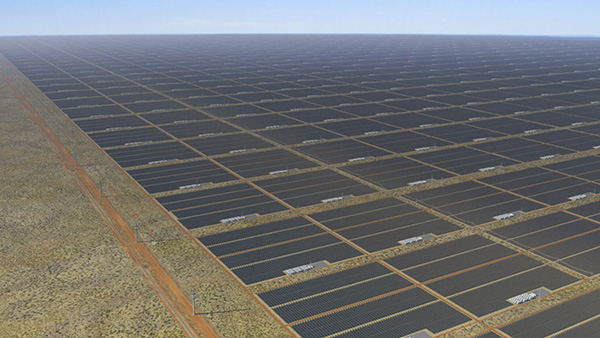
But it’s a win for the rare Typhonium plant, and possibly also for millions of crabs around Indonesia who might have been hypnotized by undersea cables like the ones near the UK are. And who knows what that cable would have done electromagnetically for turtles, dugongs, whales and dolphins? Where are the Greens when giant experimental industrial parks span 5,000km of wilderness?
Today the massive Sun Cable project collapsed into voluntary administration four years after promising to build the world’s largest solar power plant in the Northern Territory. Sun Cable was a $35 billion project supposedly to collect those sacred green electrons on a 12,000 hectare “farm” in Australia (120 square kilometers) and send them to Singapore via an 800 km land cable and then a 4,200km undersea cable. It was theoretically going to be nine times bigger than the largest solar plant in the world, and use a cable 6 times longer than the longest one ever built.
So this was ambition-on-steroids, and had economies of scale up the kazoo, and possibly as much sunlight as any place on Earth, but it was still obscenely uneconomic and expensive. Allegedly, environmentally, it would have achieved the equivalent of taking 2.5 million cars off the road each year, in other words, virtually nothing or even less. For $30b they were reducing the small Australian car fleet by… 12%.
The numbers never made sense unless the world valued green electrons so much more than black, brown, blue, red or white ones. That’s $30 billion for just 3.2GW of reliable energy? The same money buys quite a few nuclear plants that will last five times longer and reduce CO2 by vastly more. But it was never about “saving the world”, was it — just about building bigger subsidy farms, and winning a fashion contest at inner city dinner parties.
 The numbers never made sense. Ultimately the project was supposed to supply 15% of Singapore’s energy needs and also make 800MW for Darwin initially. When finished there would be “20GWp” in toto (or Gigawatt-peak). The plan also included 36-42 gigawatt hours of battery storage too, no doubt providing more jobs for child slaves in the Congo.
The legacy media is a defacto PR team for unreliable energy, so they’re selling this collapse as the fault of “Big Egos” — not because the solar project was a stupid idea.
Chnticleer, Australian Financial Review
It is feasible the world’s most ambitious solar energy generation project will go ahead. But don’t expect billionaires Mike Cannon-Brookes and Andrew Forrest to both be involved.
Sun Cable said the appointment of administrators followed “the absence of alignment with the objectives of all shareholders”.
“Whilst funding proposals were provided, consensus on the future direction and funding structure of the company could not be achieved,” it said.
Sun Cable must have been under considerable financial pressure leading into the end of 2022 judging from documents lodged with the corporate regulator about a series B preference share issue.
Assuming this preference share issue is not related to the capital raising announced last March, Sun Cable was forced to raise $28 million in late December through the issue of 11.9 million series B preference shares at $2.34 each. It is difficult to understand why a company such as Sun Cable, which is in the regulatory approval stage of its evolution, is apparently burning through so much cash.
In essence, Sun Cable’s strategic value is really at the mercy of the choices made by the Singaporeans, including how much they are willing to pay. Whoever buys Sun Cable will have to have deep pockets, because something of this scale and ambition will inevitably lose money well into the 2030s.
h/t Scott A, David B, Graeme#4, David Maddison
9.9 out of 10 based on 117 ratings
8.6 out of 10 based on 8 ratings
By The Babylon Bee.
Experts Say They Don’t Know What Thing Is Causing Everyone To Suddenly Collapse, But It’s Definitely Not That One Thing.
 “It’s too early to say what could be causing this, but it’s never too early to say what isn’t causing this,” said local expert, Dr. Scott Rufflinger. “This could be caused by anything. But the one thing we know for certain is that it’s definitely not what we’re all thinking that’s behind this — if you know what I mean. We can go ahead and rule that thing out right now because Science just called us on the phone and told us not to discuss it. We always follow Science.” “It’s too early to say what could be causing this, but it’s never too early to say what isn’t causing this,” said local expert, Dr. Scott Rufflinger. “This could be caused by anything. But the one thing we know for certain is that it’s definitely not what we’re all thinking that’s behind this — if you know what I mean. We can go ahead and rule that thing out right now because Science just called us on the phone and told us not to discuss it. We always follow Science.”
According to sources, experts have been working tirelessly around the clock to try and get to the bottom of why so many seemingly perfectly healthy, athletic people are falling over suddenly.

“I wish I could point to something in the past year or two that large groups of people were exposed to, or forced into, but nothing comes to mind,” added Dr. Rufflinger. “If only there was one thing all these patients had in common.”
__________________________________
If only it was all a joke
The studies
9.8 out of 10 based on 97 ratings
6.9 out of 10 based on 19 ratings
8.4 out of 10 based on 14 ratings
By Jo Nova
Is the dam wall breaking?
Last week the Wall Street Journal ran with a headline: Are vaccines fuelling new Covid variants? It would have been unthinkable last year. Back then, it was a pandemic of the evil un-vaccinated.
Tonight Consultant cardiologist Assem Malhotra has a double page spread in the UK Telegraph warning… “the jab can rapidly speed up the development of heart disease”. In his twitter feed he’s very excited: “Do they have proof? YES MORE THAN ENOUGH! “We’ve finally broken British mainstream news“. That tweet has now been seen by 2.1 million people. Obviously other people are excited too.
But steel yourself, the mainstream press is 3 years behind the news and the first journalists putting their heads over the parapet are making sure risky sentences are buried six feet deep in qualifiers. The risk of myocarditis is small they say, people recover fast (except for the ones that died), the vaccines are still useful, Covid causes myocarditis too, etc etc, ad nauseum.
Sarah Knapton, Telegraph
While there have always been anti-vaxxers, this new concern is drawing in people from outside usual conspiracy theory circles
The feature starts with a long introduction assuring us that Dr Malhotra is an expert who used to believe in the vaccines. What’s new is that he is not made out to be a crazy man.
Dr Malhotra is right to say that heart deaths have increased alarmingly in the last few years. According to the British Heart Foundation there have been around 30,000 more deaths than expected involving heart disease since the pandemic began – more than 230 additional deaths over expected rates each week.
While Dr Malhotra acknowledges that other causes are a factor, he remains convinced that vaccines are also playing a role. He cites Pfizer’s own trial data, which showed there were four cardiac arrests in those who took the vaccine compared with just one in the placebo group.
Ponder for a moment how blandly that was put. Some 30,000 people might have been killed by the vaccine. Well, it was just playing a role…
Only now, thirteen months late, is the Telegraph softly telling its audience about the Gundry trial of cardiac risk markers that doubled after vaccination. The same one we discussed here in November 2021.
They’re also making up excuses to cover their own spineless insouciance for the last three years:
The problems are only now coming to light because Phase 3 clinical trials have too few people enrolled to pick up rare events, particularly if the heightened risk occurs in a small subgroup – such as young men.
Buried at the bottom — the meme that may start to take off:
Dr Malhotra believes the jab can rapidly speed up the development of heart disease, and now includes vaccine damage in his diagnoses of patients.
“When you’ve got a pre-dose angiogram and a post-dose one that shows damage that usually takes years to trigger, you have to think of the most likely explanation,” said Dr Malhotra.
The Red Pill cometh
As word spreads to a new audience, suddenly thousands more people will be noticing things they didn’t notice before. They might realize Aunt Millie got boosted a few weeks before her heart attack, or that their own heart hasn’t been quite the same, or that there was a 15 year old at school who died suddenly. The gnawing sense that the vaccines can cause harm may ignite the ripe fields of discontent.
Once alerted to a pattern, a brain is good at finding it everywhere. For once, confirmation bias is our friend. Hopefully this is where things start to unravel for the Big Lie — “Safe and Effective”.
9.7 out of 10 based on 138 ratings
8.6 out of 10 based on 16 ratings
8 out of 10 based on 22 ratings
By Jo Nova
 Here we are after half a billion people caught Covid (that we know of) and now someone studies zinc tablets and mortality in a proper randomized trial? Here we are after half a billion people caught Covid (that we know of) and now someone studies zinc tablets and mortality in a proper randomized trial?
It turns out zinc treatment reduced the length of Covid suffering by about 3 days and the people who took it were 40% less likely to die.
The thing we learn from this study is that yet again, publicly funded science is killing people because it is not studying the obvious, cheap, low risk solutions that can’t be patented. Ministers of Health are apparently Ministers for Pharmaceutical profits.
This is the scandal:
To our knowledge, this study is the first well-powered, placebo-controlled clinical trial to report results of zinc for the treatment of patients with COVID-19.
To summarize the background: We already knew zinc was useful against quite a few viruses and have known this since 1974. We also knew from another study that 6 out of 10 Covid patients were deficient in zinc, and those patients were more likely to die. Odds were that zinc would be useful, low cost and low risk, so… we waited two years and let a few million people die before someone, somewhere managed to do this obvious study with 400 patients.
The activity of zinc against infectious pathogens has been demonstrated in a variety of viral species [12–16]. However, there is very scant information available on the role and effect of zinc in coronavirus disease [17–21]. Jothimani et al [18] in a recently published study including 47 patients with COVID-19 demonstrated that zinc deficiency was present in more than half (57.4%) of their cohort and was associated with prolonged hospitalization and increased mortality compared with a control group. In 4 outpatients with COVID-19, Finzi [19] reported that treatment with zinc reduced disease symptoms within 24 hours.
In the meantime we ignored nutrients, food and exercise and spent billions of dollars on secret deals, carrying out mass experimentation with wildly new technologies and unknown risks instead. And we even did it on our children.
Basically people who took zinc were better off than those who didn’t
This applied to old folks, young people, early treatment, late treatment and either sex:
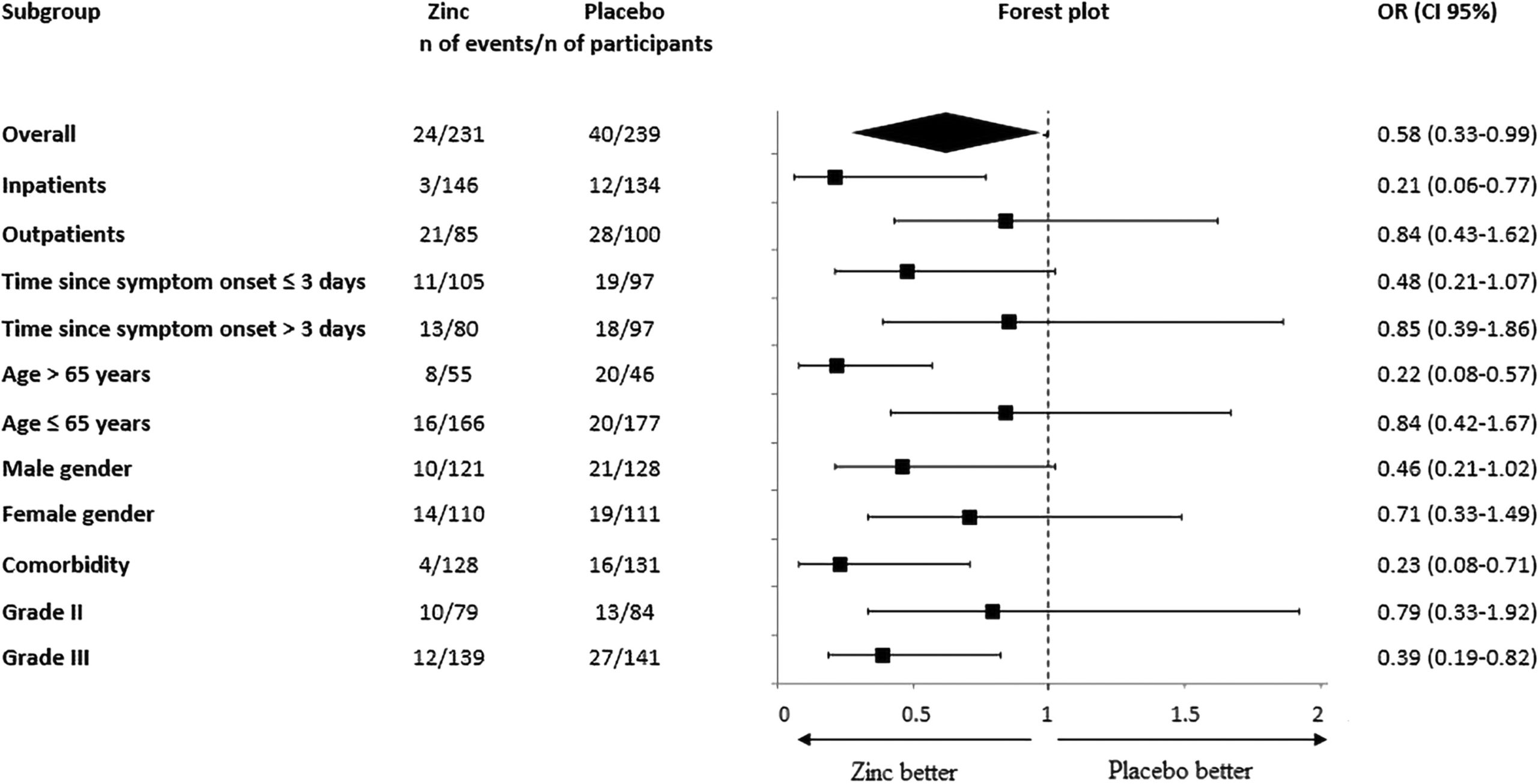 Zinc is better than “no zinc”. (Click to enlarge)
Zinc is used in over 300 enzymes and 1000 transcription factors (things we need to read our genes). It’s such an intrinsic part of us, fully 10% of all human proteins bind zinc. After iron, it is the second most common trace metal inside us and we carry about 2 – 4 grams of zinc within.
But the sad truth is people were using zinc in treatments nearly 2,000 years ago. Even the ancient Romans arguably knew more medicine than most Ministers of Health.
The oldest known pills were made of the zinc carbonates hydrozincite and smithsonite. The pills were used for sore eyes and were found aboard the Roman ship Relitto del Pozzino, wrecked in 140 BC.
—Wikipedia
And in case you were wondering, the modern Covid research was eventually done by a small African Pharmaceutical company.
“This work was supported by Opalia Recordati, Tunisia.”
They used a 25mg tablet twice a day for two weeks, which is a modest dose for a short time. It was their own brand, and presumably they want to sell more zinc tablets, so there is a conflict of interest. But unlike large western conglomerate pharmaceutical companies, perhaps they don’t have billion dollar patented anti-virals and vaccines to sell as well, so they aren’t worried that a cheap supplement will dent their most profitable products.
Despite the conflict of interest the results fit with other minor, smaller or imperfect studies on zinc that also show benefits in this order. For various reasons previous studies were usually too small, or retrospective, or studying a mixed bag of treatments, so hard to unpack. And the truth is, this study should be replicated with different doses and larger groups too, and it should have been done 30 years ago with other viruses already. How many man-years of productivity have we lost on influenza /RSV/ coronaviruses which might have been saved if zinc was used?
Why do we have publicly funded universities?
It is exactly this kind of “non-profit-making” research that taxpayers probably think our universities would be doing. Isn’t it time to advance science and stop funding universities? What is the point?
h/t David Maddison
REFERENCES
Keep reading →
9.5 out of 10 based on 107 ratings
…
7.7 out of 10 based on 14 ratings
 Sydney Observatory in the centre of the city in 1864. (Courtesy of the State Library of NSW.) By Jo Nova
For the first time in 163 years of records at Sydney Observatory the temperature didn’t even crack 32 degrees C (or 90F) for the whole year of 2022. Despite CO2 being at higher levels than ever, Sydney has never had temperatures that were so un-extreme.
The hottest day all year at this historic site was just 31.9 C. When researcher Chris Gillham first mentioned this, I assumed he must have meant “for the month of December”. I could not believe Sydney would go a whole year without a single hot day, but here it is. Gillham graphed the hottest day of the year at Sydney Observatory every year since 1859 and it really is unprecedented.
So far the total media attention on this point is one tweet by a weatherzone meteorologist and a paragraph in The Sydney Morning Herald. (h/t b.nice and RealClimateScience). Has the BoM even said a word? If it was the hottest year in 163 years, we’d know all about it. The BoM is an advertising agency for government policies.
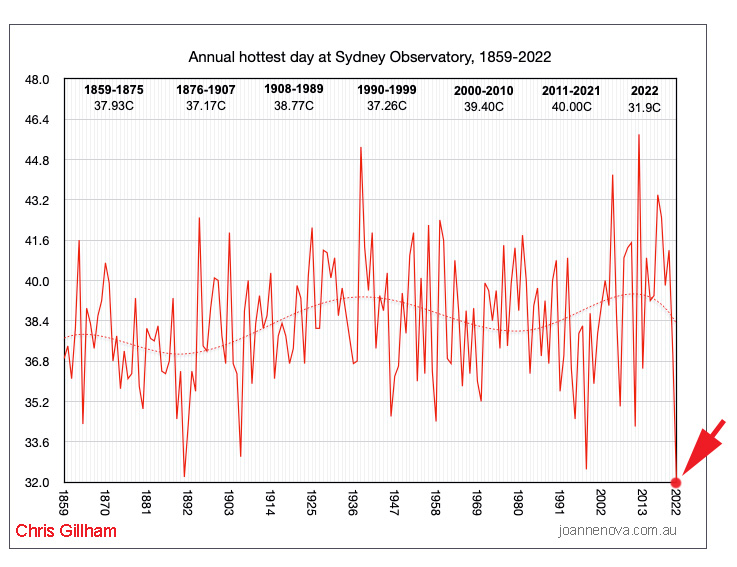 And this is despite many site changes which make the site warmer, including all the concrete, bitumen and 6-lane freeways added in the area. During the time shown in the graph, Sydney grew from 95,000 to 5 million people. And this is despite many site changes which make the site warmer, including all the concrete, bitumen and 6-lane freeways added in the area. During the time shown in the graph, Sydney grew from 95,000 to 5 million people.
Sydney Observatory is right in the heart of city, surrounded by cars and yet it would have felt hotter there in 1859.
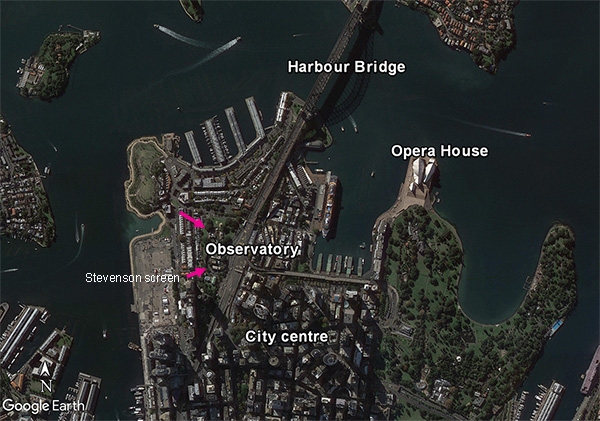 Sydney Observatory is right next to the busiest roads and tallest buildings in Sydney.
Soon children won’t know what summer is… 🙂
Most years in Sydney there are 6 to 20 days of temperatures above 32C. Many thanks to Chris Gillham for doing all the work to make these graphs.
 What happened to that extreme heat? What happened to that extreme heat?
The reason for the lack of hot days is due to the record amount of rain. In 2022 2,530 mm of water fell on Sydney, breaking the previous rainfall record of 2,194mm set in 1950. When soils are wet, sunlight must evaporate the moisture before the soil and air above it, can start to heat up. So more rain means cooler maximums.
To get hotter maximum temperatures takes bone dry sand. If only the Bureau of Meteorology could predict rainfall, droughts and La Nina’s, they might also be able to predict which years would have extreme heat? Wouldn’t that be handy?
Instead, the models are so bad, even the expert climate modelers don’t want to use their own models to help invest their own retirement funds.
For most people under 70 in Sydney this has been one the three coolest years they’ve ever known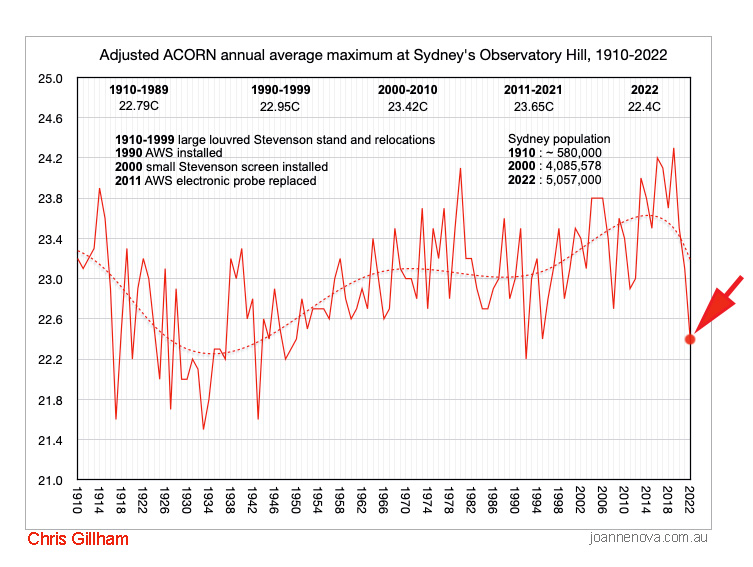
Keep reading →
9.7 out of 10 based on 85 ratings
|
JoNova A science presenter, writer, speaker & former TV host; author of The Skeptic's Handbook (over 200,000 copies distributed & available in 15 languages).

Jo appreciates your support to help her keep doing what she does. This blog is funded by donations. Thanks!


 Follow Jo's Tweets
Follow Jo's Tweets To report "lost" comments or defamatory and offensive remarks, email the moderators at: support.jonova AT proton.me
Statistics
The nerds have the numbers on precious metals investments on the ASX
|





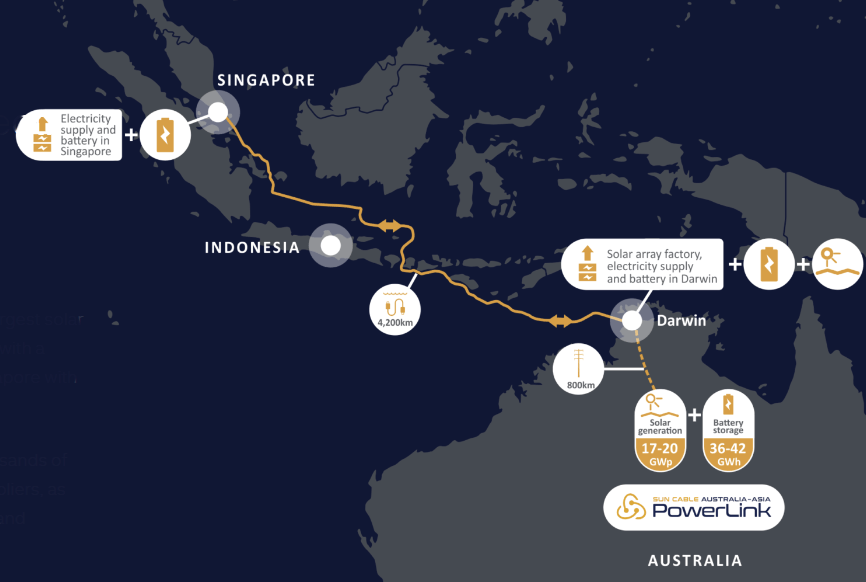



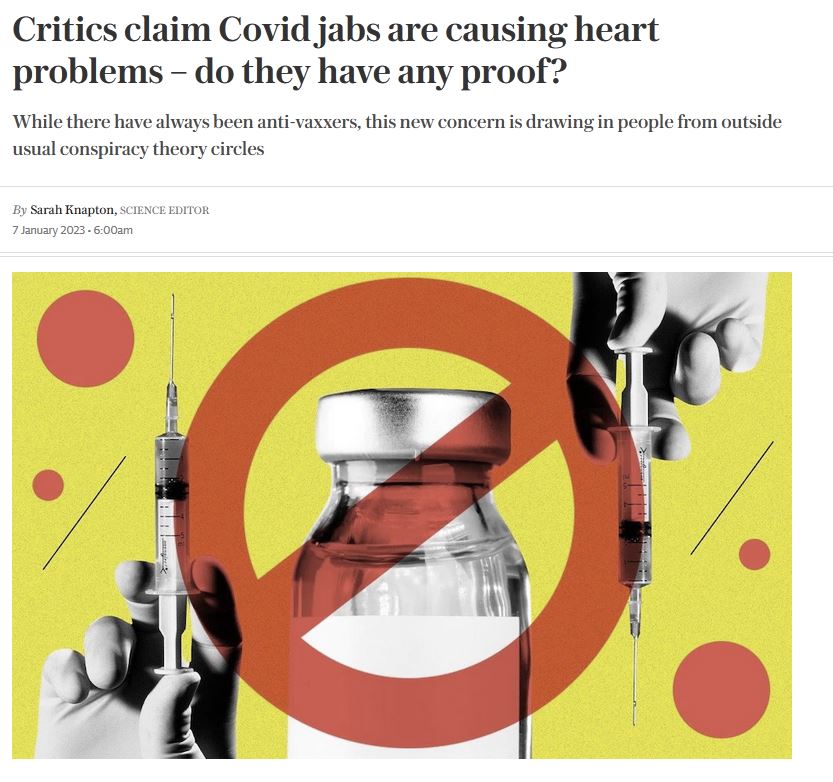

















Recent Comments